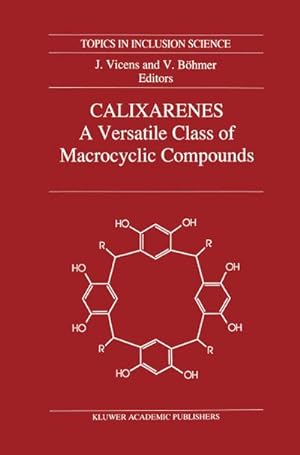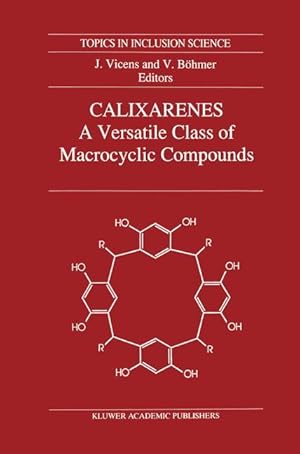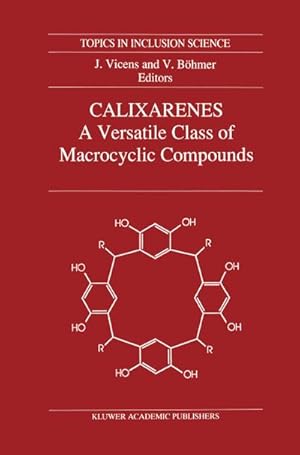calixarenes versatile class macrocyclic (17 résultats)
Filtres de recherche
Type d'article
- Tous les types de produits
- Livres (17)
- Magazines & Périodiques (Aucun autre résultat ne correspond à ces critères)
- Bandes dessinées (Aucun autre résultat ne correspond à ces critères)
- Partitions de musique (Aucun autre résultat ne correspond à ces critères)
- Art, Affiches et Gravures (Aucun autre résultat ne correspond à ces critères)
- Photographies (Aucun autre résultat ne correspond à ces critères)
- Cartes (Aucun autre résultat ne correspond à ces critères)
- Manuscrits & Papiers anciens (Aucun autre résultat ne correspond à ces critères)
Etat En savoir plus
- Neuf (14)
- Comme neuf, Très bon ou Bon (2)
- Assez bon ou satisfaisant (1)
- Moyen ou mauvais (Aucun autre résultat ne correspond à ces critères)
- Conformément à la description (Aucun autre résultat ne correspond à ces critères)
Particularités
- Ed. originale (Aucun autre résultat ne correspond à ces critères)
- Signé (Aucun autre résultat ne correspond à ces critères)
- Jaquette (Aucun autre résultat ne correspond à ces critères)
- Avec images (10)
- Sans impressions à la demande (11)
Langue (1)
Prix
- Tous les prix
- Moins de EUR 20 (Aucun autre résultat ne correspond à ces critères)
- EUR 20 à EUR 45
- Plus de EUR 45
Livraison gratuite
- Livraison gratuite à destination de Etats-Unis (Aucun autre résultat ne correspond à ces critères)
Pays
Evaluation du vendeur
-
Calixarenes: A Versatile Class of Macrocyclic Compounds (Topics in Inclusion Science, 3)
Vendeur : Zubal-Books, Since 1961, Cleveland, OH, Etats-Unis
EUR 43,38
EUR 3,89 expédition vers Etats-UnisQuantité disponible : 1 disponible(s)
Ajouter au panierEtat : Good. *Price HAS BEEN REDUCED by 10% until Monday, Nov. 10 (SALE ITEM)* 263 pp., hardcover, ex library, else text clean and binding tight. - If you are reading this, this item is actually (physically) in our stock and ready for shipment once ordered. We are not bookjackers. Buyer is responsible for any additional duties, taxes, or fees required by recipient's country.
-
Calixarenes: A Versatile Class of Macrocyclic Compounds (Topics in Inclusion Science)
Vendeur : Lucky's Textbooks, Dallas, TX, Etats-Unis
EUR 158,94
EUR 3,45 expédition vers Etats-UnisQuantité disponible : Plus de 20 disponibles
Ajouter au panierEtat : New.
-
Calixarenes: A Versatile Class of Macrocyclic Compounds (Topics in Inclusion Science)
Vendeur : Ria Christie Collections, Uxbridge, Royaume-Uni
EUR 157,10
EUR 13,62 expédition depuis Royaume-Uni vers Etats-UnisQuantité disponible : Plus de 20 disponibles
Ajouter au panierEtat : New. In.
-
Calixarenes: A Versatile Class of Macrocyclic Compounds (Topics in Inclusion Science, 3)
Vendeur : Ria Christie Collections, Uxbridge, Royaume-Uni
EUR 157,10
EUR 13,62 expédition depuis Royaume-Uni vers Etats-UnisQuantité disponible : Plus de 20 disponibles
Ajouter au panierEtat : New. In.
-
EUR 141,30
EUR 70 expédition depuis Allemagne vers Etats-UnisQuantité disponible : 5 disponible(s)
Ajouter au panierTaschenbuch. Etat : Neu. Calixarenes: A Versatile Class of Macrocyclic Compounds | Volker Böhmer (u. a.) | Taschenbuch | xii | Englisch | 2011 | Springer Netherland | EAN 9789401074025 | Verantwortliche Person für die EU: Springer Verlag GmbH, Tiergartenstr. 17, 69121 Heidelberg, juergen[dot]hartmann[at]springer[dot]com | Anbieter: preigu.
-
Calixarenes: A Versatile Class of Macrocyclic Compounds
Edité par Springer Netherlands, Springer Netherlands Nov 1990, 1990
ISBN 10 : 0792307143 ISBN 13 : 9780792307143
Langue: anglais
Vendeur : buchversandmimpf2000, Emtmannsberg, BAYE, Allemagne
EUR 160,49
EUR 60 expédition depuis Allemagne vers Etats-UnisQuantité disponible : 2 disponible(s)
Ajouter au panierBuch. Etat : Neu. Neuware -The tenn 'calixarenes', introduced in 1978 by D. Gutsche to describe the cyclic oligomers produced by condensation of p-substituted phenols with fonnaldehyde, is now universally accepted in the chemical community. The condensation of phenol with fonnaldehyde was studied in the last century by A. von Baeyer. Early in this century, L. Baekeland produced the first entirely synthetic polymers from phenol-fonnaldehyde condensates and the possibility that cyclic condensation products could be obtained from t-butylphenol, and fonnaldehyde was mentioned as early as in the beginning of the 1940's by A. Zinke. Despite their long history, the realisation that calixarenes may have very significant applications and uses in supramolecular chemistry is a relatively recent phenomenon. Calixarene chemistry, in contrast to their discovery, started slowly in the 1970's but rapidly gained momentum throughout the 1980's. Following C. Pedersens discovery of the crown ethers and the seminal developments of J. -M. Lehn and D. Cram with cryptands and spherands - all three honoured with the 1987 Nobel Chemistry Prize - the time was right for a surge of interest in research areas, frequently referred to as host-guest chemistry, receptor or supramolecular chemistry, and including important comparisons with biological processes and the development of new advanced materials. Now, the cyclic, bowl or basket-shaped calixarene molecules were looked on in a different light. Rather than 'having developed from harmful by-products of phenoplasts manufacture' they were now seen as potentially valuable macrocyclic receptor molecules.Springer Verlag GmbH, Tiergartenstr. 17, 69121 Heidelberg 280 pp. Englisch.
-
EUR 167,14
EUR 62,15 expédition depuis Allemagne vers Etats-UnisQuantité disponible : 1 disponible(s)
Ajouter au panierTaschenbuch. Etat : Neu. Druck auf Anfrage Neuware - Printed after ordering - The tenn 'calixarenes', introduced in 1978 by D. Gutsche to describe the cyclic oligomers produced by condensation of p-substituted phenols with fonnaldehyde, is now universally accepted in the chemical community. The condensation of phenol with fonnaldehyde was studied in the last century by A. von Baeyer. Early in this century, L. Baekeland produced the first entirely synthetic polymers from phenol-fonnaldehyde condensates and the possibility that cyclic condensation products could be obtained from t-butylphenol, and fonnaldehyde was mentioned as early as in the beginning of the 1940's by A. Zinke. Despite their long history, the realisation that calixarenes may have very significant applications and uses in supramolecular chemistry is a relatively recent phenomenon. Calixarene chemistry, in contrast to their discovery, started slowly in the 1970's but rapidly gained momentum throughout the 1980's. Following C. Pedersens discovery of the crown ethers and the seminal developments of J. -M. Lehn and D. Cram with cryptands and spherands - all three honoured with the 1987 Nobel Chemistry Prize - the time was right for a surge of interest in research areas, frequently referred to as host-guest chemistry, receptor or supramolecular chemistry, and including important comparisons with biological processes and the development of new advanced materials. Now, the cyclic, bowl or basket-shaped calixarene molecules were looked on in a different light. Rather than 'having developed from harmful by-products of phenoplasts manufacture' they were now seen as potentially valuable macrocyclic receptor molecules.
-
Calixarenes: A Versatile Class of Macrocyclic Compounds
Edité par Springer Netherlands, Springer Netherlands, 1990
ISBN 10 : 0792307143 ISBN 13 : 9780792307143
Langue: anglais
Vendeur : AHA-BUCH GmbH, Einbeck, Allemagne
EUR 168,73
EUR 62,94 expédition depuis Allemagne vers Etats-UnisQuantité disponible : 1 disponible(s)
Ajouter au panierBuch. Etat : Neu. Druck auf Anfrage Neuware - Printed after ordering - The tenn 'calixarenes', introduced in 1978 by D. Gutsche to describe the cyclic oligomers produced by condensation of p-substituted phenols with fonnaldehyde, is now universally accepted in the chemical community. The condensation of phenol with fonnaldehyde was studied in the last century by A. von Baeyer. Early in this century, L. Baekeland produced the first entirely synthetic polymers from phenol-fonnaldehyde condensates and the possibility that cyclic condensation products could be obtained from t-butylphenol, and fonnaldehyde was mentioned as early as in the beginning of the 1940's by A. Zinke. Despite their long history, the realisation that calixarenes may have very significant applications and uses in supramolecular chemistry is a relatively recent phenomenon. Calixarene chemistry, in contrast to their discovery, started slowly in the 1970's but rapidly gained momentum throughout the 1980's. Following C. Pedersens discovery of the crown ethers and the seminal developments of J. -M. Lehn and D. Cram with cryptands and spherands - all three honoured with the 1987 Nobel Chemistry Prize - the time was right for a surge of interest in research areas, frequently referred to as host-guest chemistry, receptor or supramolecular chemistry, and including important comparisons with biological processes and the development of new advanced materials. Now, the cyclic, bowl or basket-shaped calixarene molecules were looked on in a different light. Rather than 'having developed from harmful by-products of phenoplasts manufacture' they were now seen as potentially valuable macrocyclic receptor molecules.
-
Calixarenes: A Versatile Class of Macrocyclic Compounds
Vendeur : Revaluation Books, Exeter, Royaume-Uni
EUR 234,46
EUR 11,37 expédition depuis Royaume-Uni vers Etats-UnisQuantité disponible : 2 disponible(s)
Ajouter au panierPaperback. Etat : Brand New. 1991 edition. 280 pages. 9.25x6.10x0.64 inches. In Stock.
-
Calixarenes: A Versatile Class of Macrocyclic Compounds (Topics in Inclusion Science, 3)
Vendeur : Mispah books, Redhill, SURRE, Royaume-Uni
EUR 223,72
EUR 28,43 expédition depuis Royaume-Uni vers Etats-UnisQuantité disponible : 1 disponible(s)
Ajouter au panierPaperback. Etat : Like New. Like New. book.
-
Calixarenes, a Versatile Class of Macrocyclic Compounds (Topics in Inclusion Science) (Topics in Inclusion Science)
Vendeur : Mispah books, Redhill, SURRE, Royaume-Uni
EUR 256,51
EUR 28,43 expédition depuis Royaume-Uni vers Etats-UnisQuantité disponible : 1 disponible(s)
Ajouter au panierHardcover. Etat : Like New. Like New. book.
-
Calixarenes: A Versatile Class of Macrocyclic Compounds
Edité par Springer Netherlands Nov 1990, 1990
ISBN 10 : 0792307143 ISBN 13 : 9780792307143
Langue: anglais
Vendeur : BuchWeltWeit Ludwig Meier e.K., Bergisch Gladbach, Allemagne
EUR 160,49
EUR 23 expédition depuis Allemagne vers Etats-UnisQuantité disponible : 2 disponible(s)
Ajouter au panierBuch. Etat : Neu. This item is printed on demand - it takes 3-4 days longer - Neuware -The tenn 'calixarenes', introduced in 1978 by D. Gutsche to describe the cyclic oligomers produced by condensation of p-substituted phenols with fonnaldehyde, is now universally accepted in the chemical community. The condensation of phenol with fonnaldehyde was studied in the last century by A. von Baeyer. Early in this century, L. Baekeland produced the first entirely synthetic polymers from phenol-fonnaldehyde condensates and the possibility that cyclic condensation products could be obtained from t-butylphenol, and fonnaldehyde was mentioned as early as in the beginning of the 1940's by A. Zinke. Despite their long history, the realisation that calixarenes may have very significant applications and uses in supramolecular chemistry is a relatively recent phenomenon. Calixarene chemistry, in contrast to their discovery, started slowly in the 1970's but rapidly gained momentum throughout the 1980's. Following C. Pedersens discovery of the crown ethers and the seminal developments of J. -M. Lehn and D. Cram with cryptands and spherands - all three honoured with the 1987 Nobel Chemistry Prize - the time was right for a surge of interest in research areas, frequently referred to as host-guest chemistry, receptor or supramolecular chemistry, and including important comparisons with biological processes and the development of new advanced materials. Now, the cyclic, bowl or basket-shaped calixarene molecules were looked on in a different light. Rather than 'having developed from harmful by-products of phenoplasts manufacture' they were now seen as potentially valuable macrocyclic receptor molecules. 280 pp. Englisch.
-
Calixarenes: A Versatile Class of Macrocyclic Compounds
Vendeur : moluna, Greven, Allemagne
EUR 136,16
EUR 48,99 expédition depuis Allemagne vers Etats-UnisQuantité disponible : Plus de 20 disponibles
Ajouter au panierGebunden. Etat : New. Dieser Artikel ist ein Print on Demand Artikel und wird nach Ihrer Bestellung fuer Sie gedruckt. One: History and Synthesis of Calixarenes.- Single Step Synthesis and Properties of Calixarenes.- 1. Introduction.- 2. Single Step Synthesis of Calixarenes.- 2.1. Base-Induced Procedures.- 2.2. Acid-Catalyzed Procedures.- 2.3. Thermally Induced Procedures.-.
-
Calixarenes: A Versatile Class of Macrocyclic Compounds
Vendeur : moluna, Greven, Allemagne
EUR 136,16
EUR 48,99 expédition depuis Allemagne vers Etats-UnisQuantité disponible : Plus de 20 disponibles
Ajouter au panierEtat : New. Dieser Artikel ist ein Print on Demand Artikel und wird nach Ihrer Bestellung fuer Sie gedruckt. One: History and Synthesis of Calixarenes.- Single Step Synthesis and Properties of Calixarenes.- 1. Introduction.- 2. Single Step Synthesis of Calixarenes.- 2.1. Base-Induced Procedures.- 2.2. Acid-Catalyzed Procedures.- 2.3. Thermally Induced Procedures.-.
-
Calixarenes: A Versatile Class of Macrocyclic Compounds
Vendeur : preigu, Osnabrück, Allemagne
EUR 141,30
EUR 70 expédition depuis Allemagne vers Etats-UnisQuantité disponible : 5 disponible(s)
Ajouter au panierBuch. Etat : Neu. Calixarenes: A Versatile Class of Macrocyclic Compounds | Volker Böhmer (u. a.) | Buch | xii | Englisch | 1990 | Springer Netherland | EAN 9780792307143 | Verantwortliche Person für die EU: Springer Verlag GmbH, Tiergartenstr. 17, 69121 Heidelberg, juergen[dot]hartmann[at]springer[dot]com | Anbieter: preigu Print on Demand.
-
Calixarenes: A Versatile Class of Macrocyclic Compounds
Edité par Springer Netherlands, Springer Netherlands Sep 2011, 2011
ISBN 10 : 940107402X ISBN 13 : 9789401074025
Langue: anglais
Vendeur : buchversandmimpf2000, Emtmannsberg, BAYE, Allemagne
EUR 160,49
EUR 60 expédition depuis Allemagne vers Etats-UnisQuantité disponible : 1 disponible(s)
Ajouter au panierTaschenbuch. Etat : Neu. This item is printed on demand - Print on Demand Titel. Neuware -The tenn 'calixarenes', introduced in 1978 by D. Gutsche to describe the cyclic oligomers produced by condensation of p-substituted phenols with fonnaldehyde, is now universally accepted in the chemical community. The condensation of phenol with fonnaldehyde was studied in the last century by A. von Baeyer. Early in this century, L. Baekeland produced the first entirely synthetic polymers from phenol-fonnaldehyde condensates and the possibility that cyclic condensation products could be obtained from t-butylphenol, and fonnaldehyde was mentioned as early as in the beginning of the 1940's by A. Zinke. Despite their long history, the realisation that calixarenes may have very significant applications and uses in supramolecular chemistry is a relatively recent phenomenon. Calixarene chemistry, in contrast to their discovery, started slowly in the 1970's but rapidly gained momentum throughout the 1980's. Following C. Pedersens discovery of the crown ethers and the seminal developments of J. -M. Lehn and D. Cram with cryptands and spherands - all three honoured with the 1987 Nobel Chemistry Prize - the time was right for a surge of interest in research areas, frequently referred to as host-guest chemistry, receptor or supramolecular chemistry, and including important comparisons with biological processes and the development of new advanced materials. Now, the cyclic, bowl or basket-shaped calixarene molecules were looked on in a different light. Rather than 'having developed from harmful by-products of phenoplasts manufacture' they were now seen as potentially valuable macrocyclic receptor molecules.Springer Verlag GmbH, Tiergartenstr. 17, 69121 Heidelberg 280 pp. Englisch.
-
Calixarenes: A Versatile Class of Macrocyclic Compounds
Edité par Springer Netherlands Sep 2011, 2011
ISBN 10 : 940107402X ISBN 13 : 9789401074025
Langue: anglais
Vendeur : BuchWeltWeit Ludwig Meier e.K., Bergisch Gladbach, Allemagne
EUR 233,26
EUR 23 expédition depuis Allemagne vers Etats-UnisQuantité disponible : 2 disponible(s)
Ajouter au panierTaschenbuch. Etat : Neu. This item is printed on demand - it takes 3-4 days longer - Neuware -The tenn 'calixarenes', introduced in 1978 by D. Gutsche to describe the cyclic oligomers produced by condensation of p-substituted phenols with fonnaldehyde, is now universally accepted in the chemical community. The condensation of phenol with fonnaldehyde was studied in the last century by A. von Baeyer. Early in this century, L. Baekeland produced the first entirely synthetic polymers from phenol-fonnaldehyde condensates and the possibility that cyclic condensation products could be obtained from t-butylphenol, and fonnaldehyde was mentioned as early as in the beginning of the 1940's by A. Zinke. Despite their long history, the realisation that calixarenes may have very significant applications and uses in supramolecular chemistry is a relatively recent phenomenon. Calixarene chemistry, in contrast to their discovery, started slowly in the 1970's but rapidly gained momentum throughout the 1980's. Following C. Pedersens discovery of the crown ethers and the seminal developments of J. -M. Lehn and D. Cram with cryptands and spherands - all three honoured with the 1987 Nobel Chemistry Prize - the time was right for a surge of interest in research areas, frequently referred to as host-guest chemistry, receptor or supramolecular chemistry, and including important comparisons with biological processes and the development of new advanced materials. Now, the cyclic, bowl or basket-shaped calixarene molecules were looked on in a different light. Rather than 'having developed from harmful by-products of phenoplasts manufacture' they were now seen as potentially valuable macrocyclic receptor molecules. 280 pp. Englisch.













